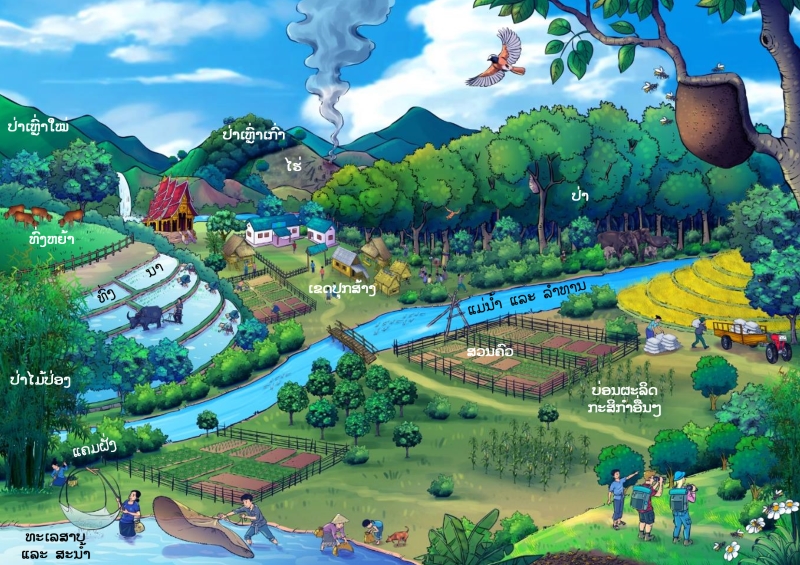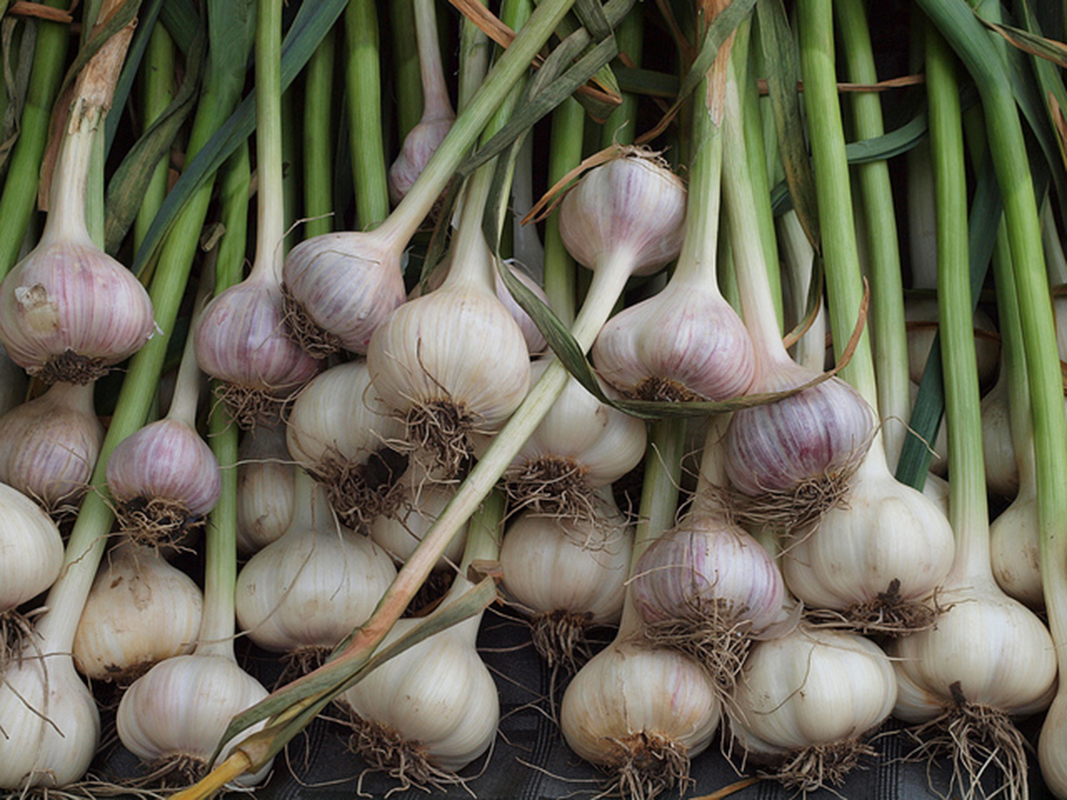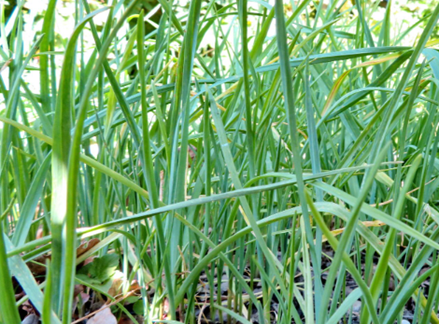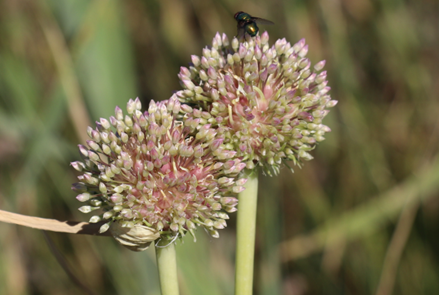ເລກລຳດັບທີ: 787
ລະດັບການຮວບຮວມຂໍ້ມູນ: ຂໍ້ມູນພື້ນຖານ
ປັບປູງຄັ້ງລ່າສຸດ: N/A
ກະທຽມ
Garlic
Allium sativum L.
ພືດ
ພືດລົ້ມລຸກ
ຜັກ ແລະ ພືດລົ້ມລຸກ
×
ຊື່ທ້ອງຖີ່ນ:
ຜັກທຽມ, ຜັກທຽມຈີນ, ຜັກທຽມຜື, ຜັກທຽມດໍ ( Cultivated Garlic)
ຊື່ພ້ອງ
:
Allium arenarium Sadler
Allium arenarium Sadler ex Rchb.
Allium controversum Schrad.
Allium controversum Schrad. ex Willd.
Allium longicuspis Regel
Allium ophioscorodon Link
Allium pekinense Prokh.
Allium sativum f. asiae-mediae Kazakova
Allium sativum f. pekinense (Prokh.) Makino
Allium sativum f. sagittatum Kazakova
Allium sativum f. vulgare Kazakova
Allium sativum subsp. asiae-mediae Kazakova
Allium sativum subsp. controversum (Schrad. ex Willd.) K.Richt.
Allium sativum subsp. ophioscorodon (Link) Döll
Allium sativum subsp. ophioscorodon (Link) Schübl. & G.Martens
Allium sativum subsp. pekinense (Prokh.) F.Maek.
Allium sativum subsp. sagittatum
Allium sativum subsp. sativum L., 1753
Allium sativum subsp. subrotundum (Gren. & Godr.) K.Richt.
Allium sativum subsp. vulgare
Allium sativum var. controversum (Schrad. ex Willd.) Nyman
Allium sativum var. controversum (Schrad. ex Willd.) Regel
Allium sativum var. ophioscorodon (Link) Döll
Allium sativum var. pekinense (Prokh.) F.Maek. ,
Allium sativum var. subrotundum Gren. & Godr.
Allium sativum var. vulgare Döll
Allium scorodoprasum subsp. viviparum (Regel) K.Richt.
Allium scorodoprasum var. multibulbillosum Y.N.Lee
Allium scorodoprasum var. viviparum Regel
Allium arenarium Sadler ex Rchb.
Allium controversum Schrad.
Allium controversum Schrad. ex Willd.
Allium longicuspis Regel
Allium ophioscorodon Link
Allium pekinense Prokh.
Allium sativum f. asiae-mediae Kazakova
Allium sativum f. pekinense (Prokh.) Makino
Allium sativum f. sagittatum Kazakova
Allium sativum f. vulgare Kazakova
Allium sativum subsp. asiae-mediae Kazakova
Allium sativum subsp. controversum (Schrad. ex Willd.) K.Richt.
Allium sativum subsp. ophioscorodon (Link) Döll
Allium sativum subsp. ophioscorodon (Link) Schübl. & G.Martens
Allium sativum subsp. pekinense (Prokh.) F.Maek.
Allium sativum subsp. sagittatum
Allium sativum subsp. sativum L., 1753
Allium sativum subsp. subrotundum (Gren. & Godr.) K.Richt.
Allium sativum subsp. vulgare
Allium sativum var. controversum (Schrad. ex Willd.) Nyman
Allium sativum var. controversum (Schrad. ex Willd.) Regel
Allium sativum var. ophioscorodon (Link) Döll
Allium sativum var. pekinense (Prokh.) F.Maek. ,
Allium sativum var. subrotundum Gren. & Godr.
Allium sativum var. vulgare Döll
Allium scorodoprasum subsp. viviparum (Regel) K.Richt.
Allium scorodoprasum var. multibulbillosum Y.N.Lee
Allium scorodoprasum var. viviparum Regel
ຊື່ສະກຸນ:
Amaryllidaceae
ຊະນິດໃກ້ຄຽງ:
ຜັກແປ້ນ / Garlic Chives
ຫົວຜັກບົ່ວໃຫ່ຍ / Bulb Onion
ຫົວຜັກບົ່ວໃຫ່ຍ / Bulb Onion
ບັນຍາຍລັກສະນະທາງພືດສາດ:
ຫົວກະທຽມມີລັກລັກສະນະຮູບໄຂ່ ແລະ ມີຫົວກະທຽມຂາວນ້ອຍໆປະມານ 6 ຫາ 10 ດອກ. ກ້ານດອກມີຄວາມສູງປະມານ 1 ນິ້ວ ແລະ ມີໂຄ້ງ, ໃນຂະນະທີ່ກາບມີປາຍປາກທີ່ຍາວ, ໃບເປັນເສັ້ນຊື່ ແລະ ແປ. ຊໍ່ດອກມີທັງຫົວນ້ອຍ ແລະດອກ, ກາບດອກມີສີຂາວຄືໃບຫອກ ແລະ ແຫຼມ. ກ້ານດອກສັ້ນກ່ວາກາບດອກ ໂດຍກ້ານດອກດ້ານໃນຕິ່ງນ້ອຍໆແຍກ 2 ແສກ. [1]
ກະທຽມ (Allium sativum L.) ເປັນພືດສະໝູນໄພທີ່ມີອາຍຸ 1 ປີ, ລຳຕົ້ນສູງ 20 ຫາ 70 ຊັງຕີແມັດ. ມີທັງແບບຕັງຊື່ ແລະ ນອນລຽບ.
ລຳຕົ້ນ: ລຳຕົ້ນມີກ້ານສັ້ນ, ປາຍແຫຼມທີ່ປະກອບເປັນຖາດໂຄນຮາກທີ່ເກີດອອກມາ. ລຳຕົ້ນກະທຽມປະກອບດ້ວຍກາບໃບທີ່ຊ້ອນກັນ.
ຮາກ: ລະບົບຮາກຂອງກະທຽມເປັນປະເພດທີ່ເກີດຂື້ນນເອງຕາມທຳມະຊາດ. ມີລັກສະນະເດັ່ນຄື ມີໂຄງສ້າງທີ່ຂ້ອນຂ້າງໜ້າ ແລະ ມີງ່ານ້ອຍ ມັນປະກອບມີ Epidermis, Cortex multicellular ແລະ Endoderm ທີ່ຫໍ່ຫຸມເອົາສະເຕເລດສວນກາງໄຫວ. ການຈະເລີນເຕີບໂຕຮາກຂອງກະທຽມມີຄວາມອ່ອນໄຫວຕໍ່ກັບຄວາມຊຸ່ມຊື່ນຂອງດິນແລະອຸນຫະພູມ, ການພັດທະນາຂອງລະບົບຮາກຂອງມັນບໍ່ພຽງພໍ, ຈໍາກັດຄວາມສາມາດໃນການດູດຊຶມສານອາຫານ.
ໃບ: ໃບເປັນຮູບແຂບ ແລະ ລຽງສະລັບກັນ ແຕ່ລະໃບມີກາບດອກເປັນຮູບທໍ່ກົມ. ຈໍານວນໃບຂອງຊະນິດພັນນີ້ໂດຍປົກກະຕີຈະມີປະມານ 9 ຫາ 12 ໃບ ໂດຍແຕ່ລະໃບມີຄວາມຍາວເຖິງ 40 ຊມ ແລະ ກວ້າງ 2 ຊມ. ງ່າກວ້າງ ແລະ ລຽບ ໃບທັງຫມົດແມ່ນຈະເກີດມາຈາກຫົວ.
ຫົວ: ຫົວມີຮູບຮ່າງ ແລະ ສີທີ່ຫຼາກຫຼາຍຢ່າງ ຕັ້ງແຕ່ສີຂາວ, ສີນ້ຳາຕານ, ສີນ້ຳາຕານອ່ອນ, ສີມ່ວງ, ສີມ່ວງອ່ອນ ລວມທັງສີມ່ວງຊ້ຳ. ຮູບຮ່າງຂອງມັນກົມຄາຍຮູບສ້ວຍ, ວົງມົນ, ຮູບສ້ວຍກວ້າງ ຫຼື ຮູບສ້ວຍແຄບ. ແຕ່ລະຫົວປະກອບດ້ວຍຫຼາຍກາບ ຫຼື ຟັກ ເຊິ່ງເຮັດຫນ້າທີ່ເປັນອະໄວຍະວະສືບພັນຂອງກະທຽມ. ຫົວຜັກທຽມແຕ່ລະອັນຖືກຫຸ້ມໄວ້ໂດຍເປືອກຫຸ້ມເຊິ່ງມັກຈະມີສີ ແລະ ມີກາບໃບດຽວທີ່ມີເນື້ອແນ່ນພ້ອມກັບຕານ້ອຍ. ຈໍານວນຂອງຫົວກະທຽມຈະມີແຕກຕ່າງກັນຢ່າງຫຼວງຫຼາຍໂດຍບາງຊະນິດມີ 4 ຫາ 6 ຫົວ, ໃນຂະນະທີ່ບາງຊະນິດມີ 10 ຫຼື 14 ຫົວ.
ຊໍ່ດອກ: ຊໍ່ດອກຂອງກະທຽມເປັນຊໍ່ດອກທີ່ສົມບູນແຕ່ລະຊໍ່ມີ 6 ກີບດອກ, ມີດອກ 6 ອັນ ແລະ ມີ 3 ຊໍ່ດອກ, ມີ 2 ຮູຢູ່ໃນແຕ່ລະຊໍ່. ດອກເຫຼົ່ານີ້ອາດມີຂະໜາດແຕກຕ່າງກັນ ໂດຍມີຈຳນວນ ແລະ ຫົວນ້ອຍທີ່ໝັນແຕກຕ່າງກັນ. ເຖິງຢ່າງໃດກໍ່ຕາມຄວາມສາມາດໃນສ້າງການຊໍ່ດອກບໍ່ໄດ້ມີຢູ່ໃນທຸກສາຍພັນ ລັກສະນະນີ້ແມ່ນຖືກໃຊ້ຫຼາຍທີ່ສຸດໃນອາຊີກາງແລະ ປະເທດແອສປາຍ. [5]
ກະທຽມ (Allium sativum L.) ເປັນພືດສະໝູນໄພທີ່ມີອາຍຸ 1 ປີ, ລຳຕົ້ນສູງ 20 ຫາ 70 ຊັງຕີແມັດ. ມີທັງແບບຕັງຊື່ ແລະ ນອນລຽບ.
ລຳຕົ້ນ: ລຳຕົ້ນມີກ້ານສັ້ນ, ປາຍແຫຼມທີ່ປະກອບເປັນຖາດໂຄນຮາກທີ່ເກີດອອກມາ. ລຳຕົ້ນກະທຽມປະກອບດ້ວຍກາບໃບທີ່ຊ້ອນກັນ.
ຮາກ: ລະບົບຮາກຂອງກະທຽມເປັນປະເພດທີ່ເກີດຂື້ນນເອງຕາມທຳມະຊາດ. ມີລັກສະນະເດັ່ນຄື ມີໂຄງສ້າງທີ່ຂ້ອນຂ້າງໜ້າ ແລະ ມີງ່ານ້ອຍ ມັນປະກອບມີ Epidermis, Cortex multicellular ແລະ Endoderm ທີ່ຫໍ່ຫຸມເອົາສະເຕເລດສວນກາງໄຫວ. ການຈະເລີນເຕີບໂຕຮາກຂອງກະທຽມມີຄວາມອ່ອນໄຫວຕໍ່ກັບຄວາມຊຸ່ມຊື່ນຂອງດິນແລະອຸນຫະພູມ, ການພັດທະນາຂອງລະບົບຮາກຂອງມັນບໍ່ພຽງພໍ, ຈໍາກັດຄວາມສາມາດໃນການດູດຊຶມສານອາຫານ.
ໃບ: ໃບເປັນຮູບແຂບ ແລະ ລຽງສະລັບກັນ ແຕ່ລະໃບມີກາບດອກເປັນຮູບທໍ່ກົມ. ຈໍານວນໃບຂອງຊະນິດພັນນີ້ໂດຍປົກກະຕີຈະມີປະມານ 9 ຫາ 12 ໃບ ໂດຍແຕ່ລະໃບມີຄວາມຍາວເຖິງ 40 ຊມ ແລະ ກວ້າງ 2 ຊມ. ງ່າກວ້າງ ແລະ ລຽບ ໃບທັງຫມົດແມ່ນຈະເກີດມາຈາກຫົວ.
ຫົວ: ຫົວມີຮູບຮ່າງ ແລະ ສີທີ່ຫຼາກຫຼາຍຢ່າງ ຕັ້ງແຕ່ສີຂາວ, ສີນ້ຳາຕານ, ສີນ້ຳາຕານອ່ອນ, ສີມ່ວງ, ສີມ່ວງອ່ອນ ລວມທັງສີມ່ວງຊ້ຳ. ຮູບຮ່າງຂອງມັນກົມຄາຍຮູບສ້ວຍ, ວົງມົນ, ຮູບສ້ວຍກວ້າງ ຫຼື ຮູບສ້ວຍແຄບ. ແຕ່ລະຫົວປະກອບດ້ວຍຫຼາຍກາບ ຫຼື ຟັກ ເຊິ່ງເຮັດຫນ້າທີ່ເປັນອະໄວຍະວະສືບພັນຂອງກະທຽມ. ຫົວຜັກທຽມແຕ່ລະອັນຖືກຫຸ້ມໄວ້ໂດຍເປືອກຫຸ້ມເຊິ່ງມັກຈະມີສີ ແລະ ມີກາບໃບດຽວທີ່ມີເນື້ອແນ່ນພ້ອມກັບຕານ້ອຍ. ຈໍານວນຂອງຫົວກະທຽມຈະມີແຕກຕ່າງກັນຢ່າງຫຼວງຫຼາຍໂດຍບາງຊະນິດມີ 4 ຫາ 6 ຫົວ, ໃນຂະນະທີ່ບາງຊະນິດມີ 10 ຫຼື 14 ຫົວ.
ຊໍ່ດອກ: ຊໍ່ດອກຂອງກະທຽມເປັນຊໍ່ດອກທີ່ສົມບູນແຕ່ລະຊໍ່ມີ 6 ກີບດອກ, ມີດອກ 6 ອັນ ແລະ ມີ 3 ຊໍ່ດອກ, ມີ 2 ຮູຢູ່ໃນແຕ່ລະຊໍ່. ດອກເຫຼົ່ານີ້ອາດມີຂະໜາດແຕກຕ່າງກັນ ໂດຍມີຈຳນວນ ແລະ ຫົວນ້ອຍທີ່ໝັນແຕກຕ່າງກັນ. ເຖິງຢ່າງໃດກໍ່ຕາມຄວາມສາມາດໃນສ້າງການຊໍ່ດອກບໍ່ໄດ້ມີຢູ່ໃນທຸກສາຍພັນ ລັກສະນະນີ້ແມ່ນຖືກໃຊ້ຫຼາຍທີ່ສຸດໃນອາຊີກາງແລະ ປະເທດແອສປາຍ. [5]
ນິເວດວິທະຍາ
ເຂດກະຈາຍພັນທົ່ວໂລກ:
Native to South Asia, Central Asia and northeastern Iran. Source: [6]
ເຂດກະຈາຍພັນໃນລາວ
:
ລຽບແມ່ນ້ຳຂອງພາກເໜືອ
ເຂດພູສູງສາຍພູຫຼວງ ແລະ ເຂດພູພຽງແຂວງຊຽງຂວາງ
ທົ່ງພຽງວຽງຈັນ
ເຂດລຽບແມ່ນ້ຳຂອງພາກໃຕ້
ພູພຽງບໍລິເວນ
ເຂດພູສູງສາຍພູຫຼວງ ແລະ ເຂດພູພຽງແຂວງຊຽງຂວາງ
ທົ່ງພຽງວຽງຈັນ
ເຂດລຽບແມ່ນ້ຳຂອງພາກໃຕ້
ພູພຽງບໍລິເວນ

ເຂດກະຈາຍພັນຕາມພູມສັນຖານ
:
ທົ່ງນາ
ເຂດກະສິກຳອື່ນໆ
ສວນຄົວ
ເຂດກະສິກຳອື່ນໆ
ສວນຄົວ

ສະເພາະຖິ່ນໃນລາວ:
ພື້ນເມືອງ
ຮຸກຮານ
:
ບໍ່ຮຸກຮານ
ສະຖານະພາບການອະນູຮັກ IUCN
:
ບໍ່ມີຄວາມສ່ຽງ
ສະຖານະພາບການອະນຸຮັກແຫ່ງຊາດລາວ
:
ບໍ່ຖືກລະບຸໃນບັນຊີປະເພດໃດ
ການນຳໃຊ້
ປະເພດການນຳໃຊ້:
ອາຫານ
ພືດເປັນຢາ
ເຄື່ອງດື່ມ
ວັດທະນະທຳ ແລະ ຮີດຄອງ
ພືດເປັນຢາ
ເຄື່ອງດື່ມ
ວັດທະນະທຳ ແລະ ຮີດຄອງ
ບັນຍາຍການນຳໃຊ້:
ອາຫານ ແລະ ເຄື່ອງດື່ມ: ແຕ່ລະພາກສ່ວນຂອງຕົ້ນກະທຽມສາມາດກິນໄດ້ ແລະ ນຳໃຊ້ເປັນເຄື່ອງປຸງຢ່າງກວ້າງຂວາງໃນທົ່ວໂລກ. ຫົວກະທຽມທີ່ມີກິ່ນຫອມທີ່ແມ່ນສ່ວນປະກອບທີ່ນິຍົມຫຼາຍທີ່ສຸດ, ມັກໃຊ້ສົດ, ໃນຮູບແບບຂອງຜົງແຫ້ງ ຫຼື ນ້ຳມັນ. ບົດ ຫຼື ບົດຫົວຜັກທຽມສົດຊ່ວຍເພີ່ມລົດຊາດ ແລະ ກິ່ນຫອມ. ນອກຈາກນັ້ນ, ກາບດອກກະທຽມ ແລະ ໃບແມ່ນໄດ້ຖືກນຳໃຊ້ໃນການປຸງແຕ່ງອາຫານ, ໃນຂະນະທີ່ຫົວກະທຽມຂຽວຍັງອ່ອນຈະຖຶກນຳໄປໃຊ້ໃນອາຫານອາຊີຕາເວັນອອກສຽງໃຕ້ ແລະ ຈີນບາງຈານ. [7]
ການຢາ: ກະທຽມໄດ້ຖືກນໍາໃນການແພດ ຕັ້ງແຕ່ສະໄໝ ບູຮານ ເພື່ອຄຸນສົມບັດດ້ານການຢາ. ຫົວກະທຽມພົບເຫັນຢູ່ໃນຢາພື້ນເມືອງຫຼາຍຊະນິດ.ໃນປະເທດອິນເດຍ ນ້ຳກະທຽມ ຫຼື ຢາຕົ້ມທີ່ເຮັດຈາກຫົວກະທຽມແມ່ໃຊ້ເພື່ອບັນເທົາອາການໄອ, ໄຂ້ ແລະເຈັບຫູ ພ້ອມທັງປັບປຸງສະພາບຜິວໜັງ. ການໃຊ້ຢາພື້ນເມືອງຂອງ Ayurvedic ແລະ Siddha, ນ້ຳກະທຽມໄດ້ຖືກນໍາໃຊ້ເພື່ອບັນເທົາອການ sinus.
ສານສະກັດຈາກຫົວຜັກທຽມແຫ້ງໄດ້ຖືກນໍາໃຊ້ໃນຢາ Unani ເພື່ອຄວບຄຸມການເປັນປະຈໍາເດືອນ, ຮັກສາບັນຫາການຍ່ອຍອາຫານ ແລະ ອາການໄຂ້.
ສານສະກັດນ້ຳຮ້ອນໂດຍເອົາກະທຽມປະສົມກັບນໍ້າເຜິ້ງ ເປັນຢາບັນເທົາອາການໄອຊຳເຮືອ ແລະ ແມ່ທ້ອງໃນລຳໄສ້ [7]. ກະທຽມມີສັບພະຄຸນໃນ ການບັນເທົາບັນຫາສຸຂະພາບຕ່າງໆເນື່ອງຈາກມີສວນປະກອບ ອໍຣກາໂນຊັລເຟລ ແລະ ສານຕ້ານອະນຸມູນອິດສະລະສູງ. ພືດຊະນິດນີ້ມີສ່ວນປະກອບຈໍານວນຫຼວງຫຼາຍທີ່ມີຄຸນສົມບັດໃນການປັບພູມຄຸ້ມກັນ. ເມື່ອກະທຽມຖືກ ບົດ ຫຼື ສັບ ມັນຈະປ່ອຍສານ ທີ່ເອີ້ນວ່າ Alliinase ອອກມາ ເຊິ່ງກະຕຸ້ນການສ້າງ Allicin. ການກະກ້ຽມກະທຽມທີ່ແຕກຕ່າງກັນ ເຊັ່ນ: ສານສະກັດຈາກຜັກທຽມເກົ່າ ແລະນ້ຳມັນກະທຽມ ມີປະສິດທິພາບໃນການປ້ອງກັນຄວາມສ່ຽງຕໍ່ສຸຂະພາບ ແລະ ຖືກນໍາໃຊ້ທົ່ວໄປເປັນອາຫານເສີມ. ອົງປະກອບເຫຼົ່ານີ້ສາມາດກໍາຈັດອະນຸມູນອິດສະລະ,ປ້ອງກັນເຍື່ອຫຸ້ມເຊລຈາກຄວາມເສຍຫາຍ ແລະ ຮັກສາຄວາມສົມບູນຂອງເຊລ. ນອກຈາກນີ້, ກະທຽມຍັງປ້ອງກັນລະບົບຫົວໃຈ ແລະ ຫຼອດເລືອດ ໂດຍການຫຼຸດລົງລະດັບຄວາມດັນເລືອດ, ສະແດງໃຫ້ເຫັນການຕ້ານເກັດເລືອດ ແລະ ຫຼຸດຜ່ອນການສ້າງ Thromboxane, ດັ່ງນັ້ນມັນຊ່ວຍປ້ອງກັນຫຼອດເລືອດແຂງ ແລະ ພະຍາດທີ່ກ່ຽວຂ້ອງໄດ້. ນອກຈາກນັ້ນ, ກະທຽມຍັງມີຄຸນສົມບັດໃນການກາຍພັນ ແລະ ຍັບຍັງການແພ່ກະຈາຍຂອງເຊລ ເຮັດໃຫ້ມັນມີຄວາມສົນໃຈສໍາລັບການແຊກແຊງທາງເຄມີ. ສານປະກອບ Organosulfur ຈາກະກທຽມສາມາດພິສູດໄດ້ແລ້ວວ່າມີປະສິດຕິພາບໃນການຍັບຍັ້ງການຂະຫຍາຍຕົວຂອງມະເຮັງທັງປູກຖ່າຍ ແລະ ເກີດຂື້ນເອງໄດ້ຢ່າງມີປະສິດທິຜົນໃນສັດທົດລອງ ໂດຍບໍ່ມີຜົນຂ້າງຄຽງໃດໆ. [8]
ເທດສະການ: ກະທຽມຖືເປັນສັນຍາລັກໃນເທດສະການ ນາວຣູຊ ວັນຂືນປີໃຫມ່ຂອງຊາວ ເປີເຊຍ. ນາວຣູຊ ເປັນກເທດສະການສະເຫຼີມສະຫຼອງການມາຮອດຂອງລະດູໃບໄມ້ປົງ ແລະ ຖືເປັນມື້ທໍາອິດຂອງປະຕິທິນ ອີຣ່ານ. ປະເພນີອັນໜຶ່ງທີ່ຈັດຂື້ນໃນມື້ນີ້ ໄດ້ແກການຕົບແຕ່ງ ໂຕະຮາທຊິນ ໂດຍຂອງຕົບແຕ່ງ 7 ຊິ້ນ ຂື້ນຕົ້ນດ້ວຍຕົວອັກສອນ 's' ໃນພາສາ ເປີເຊຍ ໂດຍໃນແຕ່ລະຊິ້ນສະແດງເຖິງຄວາມຫວັງສໍາລັບປີໃຫມ່. ກະທຽມ ("ຊີ" ໃນພາສາ ເປີເຊຍ) ແມ່ນຫນຶ່ງໃນນັ້ນ, ເຊິ່ງເປັນຕົວແທນຂອງຢາ ແລະ ສຸຂະພາບທີ່ດີ. [7]
ການຢາ: ກະທຽມໄດ້ຖືກນໍາໃນການແພດ ຕັ້ງແຕ່ສະໄໝ ບູຮານ ເພື່ອຄຸນສົມບັດດ້ານການຢາ. ຫົວກະທຽມພົບເຫັນຢູ່ໃນຢາພື້ນເມືອງຫຼາຍຊະນິດ.ໃນປະເທດອິນເດຍ ນ້ຳກະທຽມ ຫຼື ຢາຕົ້ມທີ່ເຮັດຈາກຫົວກະທຽມແມ່ໃຊ້ເພື່ອບັນເທົາອາການໄອ, ໄຂ້ ແລະເຈັບຫູ ພ້ອມທັງປັບປຸງສະພາບຜິວໜັງ. ການໃຊ້ຢາພື້ນເມືອງຂອງ Ayurvedic ແລະ Siddha, ນ້ຳກະທຽມໄດ້ຖືກນໍາໃຊ້ເພື່ອບັນເທົາອການ sinus.
ສານສະກັດຈາກຫົວຜັກທຽມແຫ້ງໄດ້ຖືກນໍາໃຊ້ໃນຢາ Unani ເພື່ອຄວບຄຸມການເປັນປະຈໍາເດືອນ, ຮັກສາບັນຫາການຍ່ອຍອາຫານ ແລະ ອາການໄຂ້.
ສານສະກັດນ້ຳຮ້ອນໂດຍເອົາກະທຽມປະສົມກັບນໍ້າເຜິ້ງ ເປັນຢາບັນເທົາອາການໄອຊຳເຮືອ ແລະ ແມ່ທ້ອງໃນລຳໄສ້ [7]. ກະທຽມມີສັບພະຄຸນໃນ ການບັນເທົາບັນຫາສຸຂະພາບຕ່າງໆເນື່ອງຈາກມີສວນປະກອບ ອໍຣກາໂນຊັລເຟລ ແລະ ສານຕ້ານອະນຸມູນອິດສະລະສູງ. ພືດຊະນິດນີ້ມີສ່ວນປະກອບຈໍານວນຫຼວງຫຼາຍທີ່ມີຄຸນສົມບັດໃນການປັບພູມຄຸ້ມກັນ. ເມື່ອກະທຽມຖືກ ບົດ ຫຼື ສັບ ມັນຈະປ່ອຍສານ ທີ່ເອີ້ນວ່າ Alliinase ອອກມາ ເຊິ່ງກະຕຸ້ນການສ້າງ Allicin. ການກະກ້ຽມກະທຽມທີ່ແຕກຕ່າງກັນ ເຊັ່ນ: ສານສະກັດຈາກຜັກທຽມເກົ່າ ແລະນ້ຳມັນກະທຽມ ມີປະສິດທິພາບໃນການປ້ອງກັນຄວາມສ່ຽງຕໍ່ສຸຂະພາບ ແລະ ຖືກນໍາໃຊ້ທົ່ວໄປເປັນອາຫານເສີມ. ອົງປະກອບເຫຼົ່ານີ້ສາມາດກໍາຈັດອະນຸມູນອິດສະລະ,ປ້ອງກັນເຍື່ອຫຸ້ມເຊລຈາກຄວາມເສຍຫາຍ ແລະ ຮັກສາຄວາມສົມບູນຂອງເຊລ. ນອກຈາກນີ້, ກະທຽມຍັງປ້ອງກັນລະບົບຫົວໃຈ ແລະ ຫຼອດເລືອດ ໂດຍການຫຼຸດລົງລະດັບຄວາມດັນເລືອດ, ສະແດງໃຫ້ເຫັນການຕ້ານເກັດເລືອດ ແລະ ຫຼຸດຜ່ອນການສ້າງ Thromboxane, ດັ່ງນັ້ນມັນຊ່ວຍປ້ອງກັນຫຼອດເລືອດແຂງ ແລະ ພະຍາດທີ່ກ່ຽວຂ້ອງໄດ້. ນອກຈາກນັ້ນ, ກະທຽມຍັງມີຄຸນສົມບັດໃນການກາຍພັນ ແລະ ຍັບຍັງການແພ່ກະຈາຍຂອງເຊລ ເຮັດໃຫ້ມັນມີຄວາມສົນໃຈສໍາລັບການແຊກແຊງທາງເຄມີ. ສານປະກອບ Organosulfur ຈາກະກທຽມສາມາດພິສູດໄດ້ແລ້ວວ່າມີປະສິດຕິພາບໃນການຍັບຍັ້ງການຂະຫຍາຍຕົວຂອງມະເຮັງທັງປູກຖ່າຍ ແລະ ເກີດຂື້ນເອງໄດ້ຢ່າງມີປະສິດທິຜົນໃນສັດທົດລອງ ໂດຍບໍ່ມີຜົນຂ້າງຄຽງໃດໆ. [8]
ເທດສະການ: ກະທຽມຖືເປັນສັນຍາລັກໃນເທດສະການ ນາວຣູຊ ວັນຂືນປີໃຫມ່ຂອງຊາວ ເປີເຊຍ. ນາວຣູຊ ເປັນກເທດສະການສະເຫຼີມສະຫຼອງການມາຮອດຂອງລະດູໃບໄມ້ປົງ ແລະ ຖືເປັນມື້ທໍາອິດຂອງປະຕິທິນ ອີຣ່ານ. ປະເພນີອັນໜຶ່ງທີ່ຈັດຂື້ນໃນມື້ນີ້ ໄດ້ແກການຕົບແຕ່ງ ໂຕະຮາທຊິນ ໂດຍຂອງຕົບແຕ່ງ 7 ຊິ້ນ ຂື້ນຕົ້ນດ້ວຍຕົວອັກສອນ 's' ໃນພາສາ ເປີເຊຍ ໂດຍໃນແຕ່ລະຊິ້ນສະແດງເຖິງຄວາມຫວັງສໍາລັບປີໃຫມ່. ກະທຽມ ("ຊີ" ໃນພາສາ ເປີເຊຍ) ແມ່ນຫນຶ່ງໃນນັ້ນ, ເຊິ່ງເປັນຕົວແທນຂອງຢາ ແລະ ສຸຂະພາບທີ່ດີ. [7]
ການປູກ ການລ້ຽງ:
ຊະນິດປູກ
ລະດູການເກັບກູ້:
ຕຸລາ
ພະຈິກ
ທັນວາ
ພະຈິກ
ທັນວາ
ການຕະຫຼາດ ແລະ ຕ່ອງໂສ້ມູນຄ່າ:
N/A
ການຄຸ້ມຄອງຈັດການ
ສະພາບໂດຍລວມ:
ກະທຽມຈະກະຍາຍພັນພືດຜ່ານກີບຂອງຫົວເປັນຫຼັກ ການຈະລີນເຕີບໂຕ ແລະ ການຂະຫຍາຍຕົວຂອງມັນແມ່ນໄດ້ອິດທິພົນຢ່າງຫຼວງຫຼາຍຈາກສະພາບສິ່ງແວດລ້ອມ ໂດຍສະເພາະອຸນຫະພູມ ແລະ ໄລຍະເວລາຂອງແສງ. ການຟັກຕົວຂອງກະທຽມຖືກທໍາລາຍເມື່ອສໍາຜັດກັບອຸນຫະພູມຂອງ 6 ຫາ 7 ອົງສາ ເຖິງແມ່ນວ່າແນວພັນເຂດຮ້ອນບໍ່ຕ້ອງການກໍ່ຕາມ. ການແຕກງອກແມ່ນຈະເກີດຂື້ນໃນແບບ Epigerminated ໂດຍຈະເກີດຂຶ້ນຫນຶ່ງຫາສອງອາທິດຫຼັງຈາກການຫວ່ານແກ່ນ ອຸນຫະພູມທີ່ເໝາະສົມສໍາລັບການຈະເລີນເຕີບໂຕຂອງພືດແມ່ນຢູ່ລະຫວ່າງ 18 ຫາ 20 ອົງສາ ໂດຍຄວາມແຕກຕ່າງຈາກສະພາບພືດໄປສູ່ສະພາບການຈະເລີນເຕີບໂຕເກີດຂື້ນຫຼັງຈາກມີໃບ 6 ຫາ 7 ໃບ. ການເຕີບໂຕຕ້ອງການອຸນຫະພູມ 25 ຫາ 30 ອົງສາ ແລະ ແສງ 14 ຫາ 16 ຊົ່ວໂມງ ການສ້າງໂຄມໄຟເກີດຂຶ້ນເປັນ 2 ໄລຍະຄື: ການແຕກໜໍ່ຂອງຫົວກະທຽມທີ່ອຸນຫະພູມປະມານ 7 ອົງສາ ຕໍ່ມາດ້ວຍການປົ່ງອອກມາຈາກຫົວກະທຽມທີ່ 20 ຫາ 25 ອົງສາ. ການສຸກແກແມ່ນສະແດງໃຫ້ເຫັນໂດຍໃບແຫ້ງຂອງໃບທໍາອິດ, ໂດຍມີວົງຈອນການຂະຫຍາຍຕົວທີ່ສົມບູນຈາກ 4 ເດືອນໃນເຂດຮ້ອນເຖິງ 9 ເດືອນໃນພູມອາກາດແບພາກເຫນືອຂອງເມດີເຕຣານຽນ. [5]
ການຄັດເລືອກສາຍພັນ:
ການຜະລິດກະທຽມຕ້ອງການປັບປຸງພັນຂອງຊະນິດນີ້ ແລະ ການປັບຕົວເຂົ້າກັບສະພາບອາກາດຕ່າງໆ. ເນື່ອງຈາກການເປັນຫມັນທີ່ສົມບູນ ແນວພັນກະທຽມໄດ້ຖືກຂະຫຍາຍພັນດ້ວຍພືດ ໂດຍຄັດເລືອກພັນໃຫມ່ຈາກກຸ່ມແນວພັນທີ່ມີຢູ່ແລ້ວ ຫຼື ຜ່ານການກາຍພັນຕາມທໍາມະຊາດແລະ ການກັກຕຸ້ນ. ໃນຊຸມປີມໍ່ໆມານີ້ ການຟື້ນຟູຄວາມອຸດົມສົມບູນຂອງກະທຽມໄດ້ເຮັດໃຫ້ມີຄວາມກ້າວຫນ້າທີ່ສໍາຄັນໃນການຄົ້ນຄວ້າແລະການປັບປຸງພັນພືດ. ປະຈຸບັນການປຸກກະທຽມໄດ້ສຸມໃສ່ 3 ວິທີຕົ້ນຕໍຄື: 1 ການປູກພືດແບບທຳມະດາຈາກການເກັບເຊື້ອພະຍາດທີ່ຫຼາກຫຼາຍ 2 ການຂະຫຍາຍພັນ ແລະ ການຄັດເລືອກຈາກປະຊາກອນທີ່ມີເພດສຳພັນ ແລະ 3 ການນຳໃຊ້ເຄື່ອງມືເຕັກໂນໂລຊີທາງດ້ານຊີວະພາບ. ເຖິງແມ່ນວ່າຈະບໍ່ມີວິທີໃໝ່ເຊັ່ນ: ການຕັດແຕ່ງຈີໂນມ ແລະ ການປັບປຸງພັນກະທຽມດ້ວຍເຄື່ອງໝາຍແຕ່ເປົ້າຫມາຍຂອງການຟື້ນຟູການຈະເລີນພັນ, ການປະສົມພັນ ແລະ ການຜະລິດເມັດພັນຍັງຄົງມີສໍາຄັນຕໍ່ຄວາມພະຍາຍາມປັບປຸງພັນໃນອະນາຄົດ. [9]
ກະທຽມຈະກະຍາຍພັນພືດຜ່ານກີບຂອງຫົວເປັນຫຼັກ ການຈະລີນເຕີບໂຕ ແລະ ການຂະຫຍາຍຕົວຂອງມັນແມ່ນໄດ້ອິດທິພົນຢ່າງຫຼວງຫຼາຍຈາກສະພາບສິ່ງແວດລ້ອມ ໂດຍສະເພາະອຸນຫະພູມ ແລະ ໄລຍະເວລາຂອງແສງ. ການຟັກຕົວຂອງກະທຽມຖືກທໍາລາຍເມື່ອສໍາຜັດກັບອຸນຫະພູມຂອງ 6 ຫາ 7 ອົງສາ ເຖິງແມ່ນວ່າແນວພັນເຂດຮ້ອນບໍ່ຕ້ອງການກໍ່ຕາມ. ການແຕກງອກແມ່ນຈະເກີດຂື້ນໃນແບບ Epigerminated ໂດຍຈະເກີດຂຶ້ນຫນຶ່ງຫາສອງອາທິດຫຼັງຈາກການຫວ່ານແກ່ນ ອຸນຫະພູມທີ່ເໝາະສົມສໍາລັບການຈະເລີນເຕີບໂຕຂອງພືດແມ່ນຢູ່ລະຫວ່າງ 18 ຫາ 20 ອົງສາ ໂດຍຄວາມແຕກຕ່າງຈາກສະພາບພືດໄປສູ່ສະພາບການຈະເລີນເຕີບໂຕເກີດຂື້ນຫຼັງຈາກມີໃບ 6 ຫາ 7 ໃບ. ການເຕີບໂຕຕ້ອງການອຸນຫະພູມ 25 ຫາ 30 ອົງສາ ແລະ ແສງ 14 ຫາ 16 ຊົ່ວໂມງ ການສ້າງໂຄມໄຟເກີດຂຶ້ນເປັນ 2 ໄລຍະຄື: ການແຕກໜໍ່ຂອງຫົວກະທຽມທີ່ອຸນຫະພູມປະມານ 7 ອົງສາ ຕໍ່ມາດ້ວຍການປົ່ງອອກມາຈາກຫົວກະທຽມທີ່ 20 ຫາ 25 ອົງສາ. ການສຸກແກແມ່ນສະແດງໃຫ້ເຫັນໂດຍໃບແຫ້ງຂອງໃບທໍາອິດ, ໂດຍມີວົງຈອນການຂະຫຍາຍຕົວທີ່ສົມບູນຈາກ 4 ເດືອນໃນເຂດຮ້ອນເຖິງ 9 ເດືອນໃນພູມອາກາດແບພາກເຫນືອຂອງເມດີເຕຣານຽນ. [5]
ການຄັດເລືອກສາຍພັນ:
ການຜະລິດກະທຽມຕ້ອງການປັບປຸງພັນຂອງຊະນິດນີ້ ແລະ ການປັບຕົວເຂົ້າກັບສະພາບອາກາດຕ່າງໆ. ເນື່ອງຈາກການເປັນຫມັນທີ່ສົມບູນ ແນວພັນກະທຽມໄດ້ຖືກຂະຫຍາຍພັນດ້ວຍພືດ ໂດຍຄັດເລືອກພັນໃຫມ່ຈາກກຸ່ມແນວພັນທີ່ມີຢູ່ແລ້ວ ຫຼື ຜ່ານການກາຍພັນຕາມທໍາມະຊາດແລະ ການກັກຕຸ້ນ. ໃນຊຸມປີມໍ່ໆມານີ້ ການຟື້ນຟູຄວາມອຸດົມສົມບູນຂອງກະທຽມໄດ້ເຮັດໃຫ້ມີຄວາມກ້າວຫນ້າທີ່ສໍາຄັນໃນການຄົ້ນຄວ້າແລະການປັບປຸງພັນພືດ. ປະຈຸບັນການປຸກກະທຽມໄດ້ສຸມໃສ່ 3 ວິທີຕົ້ນຕໍຄື: 1 ການປູກພືດແບບທຳມະດາຈາກການເກັບເຊື້ອພະຍາດທີ່ຫຼາກຫຼາຍ 2 ການຂະຫຍາຍພັນ ແລະ ການຄັດເລືອກຈາກປະຊາກອນທີ່ມີເພດສຳພັນ ແລະ 3 ການນຳໃຊ້ເຄື່ອງມືເຕັກໂນໂລຊີທາງດ້ານຊີວະພາບ. ເຖິງແມ່ນວ່າຈະບໍ່ມີວິທີໃໝ່ເຊັ່ນ: ການຕັດແຕ່ງຈີໂນມ ແລະ ການປັບປຸງພັນກະທຽມດ້ວຍເຄື່ອງໝາຍແຕ່ເປົ້າຫມາຍຂອງການຟື້ນຟູການຈະເລີນພັນ, ການປະສົມພັນ ແລະ ການຜະລິດເມັດພັນຍັງຄົງມີສໍາຄັນຕໍ່ຄວາມພະຍາຍາມປັບປຸງພັນໃນອະນາຄົດ. [9]
ໂພຊະນາການ
ຄຸນຄ່າທາງໂພຊະນາການ:
ບັນຍາຍຄຸນຄ່າທາງໂພຊະນາການ:
N/A
| ສານອາຫານ | /100g | ໝາຍເຫດ |
|---|---|---|
| ໂປຣຕີນ | 6.36 | N/A |
| ຄາໂບໄຮເດຣດ | 33.06 | N/A |
| ໄຂມັນ | 0.5 | N/A |
| ວິຕາມິນ | N/A | Vitamin B1 (0.2 mg), Vitamin B2 (0.11 g), Vitamin B3 (0.7 g), Vitamin B5 (0.596), Vitamin B6 (1.235 mg), Vitamin B9 (3 μg) and Vitamin C (31.2 mg). |
| ແຮ່ທາດ | N/A | N/A |
| ເສັ້ນໄຍ | N/A | N/A |
ອ້າງອິງ
ເຄດິດຮູບພາບ:
Garlic bulb. [1] Planet [Online]. Upload on 16 September 2020 by P. T. Schmitz. Avail-able: https://identify.plantnet.org/k-world-flora/observations/1018280254. [Accessed: 15 October 2024]
Leaves and stems. [2] iNaturalist [Online]. Uploaded on 06 September 2022 by N. T. Y. Besh-ko. Available: https://www.inaturalist.org/observations/133856865. [Ac-cessed: 15 October 2024]
Inflorescences. [3] iNaturalist [Online]. Uploaded on 26 may 2022 by B. L. Felfoul. Avail-able: https://www.gbif.org/occurrence/3949904869. [accessed: 15 Octo-ber 2024]
Leaves and stems. [2] iNaturalist [Online]. Uploaded on 06 September 2022 by N. T. Y. Besh-ko. Available: https://www.inaturalist.org/observations/133856865. [Ac-cessed: 15 October 2024]
Inflorescences. [3] iNaturalist [Online]. Uploaded on 26 may 2022 by B. L. Felfoul. Avail-able: https://www.gbif.org/occurrence/3949904869. [accessed: 15 Octo-ber 2024]
ອ້າງອິງ:
[4] World Flora Online, “Allium sativum L.,” [Online]. Available: https://www.worldfloraonline.org/taxon/wfo-0000757248. [Acessed: 16 October 2024]
[5] T. Th. K. S. Agbo so, R. B. Abdou Sani, A. D. Karim Toudou and Y. C. B. Bakasaso, “Garlic (Allium sativum L.): Overview on its Biologyand Ge-netic Markers Available for the Analysis of Its Diversity in West Africa,” Asian Journal of Biochemistry, Genetics and Molecular Biology, Article no. AJBGMB.66220, ISSN: 2582-3698, 2012. Available: http://research.manuscritpub.com/id/eprint/1785/1/131-Article%20Text-232-1-10-20220923.pdf.
[6] Global biodiversity Information Facility (GBIF), “Allium sativum L.” [Online]. Available: https://www.gbif.org/species/2856681. [Accessed: 16 October 2024]
[7] Royal Botanic Gardens Kew [Online]. Available: https://www.kew.org/plants/garlic. [Accessed: 15 October 2024]
[8] R. V. K. Upadhyay, “Garlic: A potential source of pharmaceuticals and pesticides: A review,” nternational Journal of Green Pharmacy, March 2016. [E- Book]. Available: https://shorturl.at/8MlNw
[9] R. K. M. Goldstein and E. Shemesh-Mayer, “Strategies for garlic (Alli-um sativum L.) breeding: challenges and achievements,” International Society for Horticultural Science, 2024. Available: https://www.ishs.org/ishs-article/1398_8. [Accessed: 16 October 2024]
Salunkhe, D.K.; Kadam, S.S., eds. 1998. Handbook of Vegetable Science and Technology: Production, Compostion, Storage, and Processing. Marcel Dekker. p. 397.
[5] T. Th. K. S. Agbo so, R. B. Abdou Sani, A. D. Karim Toudou and Y. C. B. Bakasaso, “Garlic (Allium sativum L.): Overview on its Biologyand Ge-netic Markers Available for the Analysis of Its Diversity in West Africa,” Asian Journal of Biochemistry, Genetics and Molecular Biology, Article no. AJBGMB.66220, ISSN: 2582-3698, 2012. Available: http://research.manuscritpub.com/id/eprint/1785/1/131-Article%20Text-232-1-10-20220923.pdf.
[6] Global biodiversity Information Facility (GBIF), “Allium sativum L.” [Online]. Available: https://www.gbif.org/species/2856681. [Accessed: 16 October 2024]
[7] Royal Botanic Gardens Kew [Online]. Available: https://www.kew.org/plants/garlic. [Accessed: 15 October 2024]
[8] R. V. K. Upadhyay, “Garlic: A potential source of pharmaceuticals and pesticides: A review,” nternational Journal of Green Pharmacy, March 2016. [E- Book]. Available: https://shorturl.at/8MlNw
[9] R. K. M. Goldstein and E. Shemesh-Mayer, “Strategies for garlic (Alli-um sativum L.) breeding: challenges and achievements,” International Society for Horticultural Science, 2024. Available: https://www.ishs.org/ishs-article/1398_8. [Accessed: 16 October 2024]
Salunkhe, D.K.; Kadam, S.S., eds. 1998. Handbook of Vegetable Science and Technology: Production, Compostion, Storage, and Processing. Marcel Dekker. p. 397.
ຜູ້ສ້າງ Factsheet:
ຜູ້ກວດສອບ Factsheet:
,


